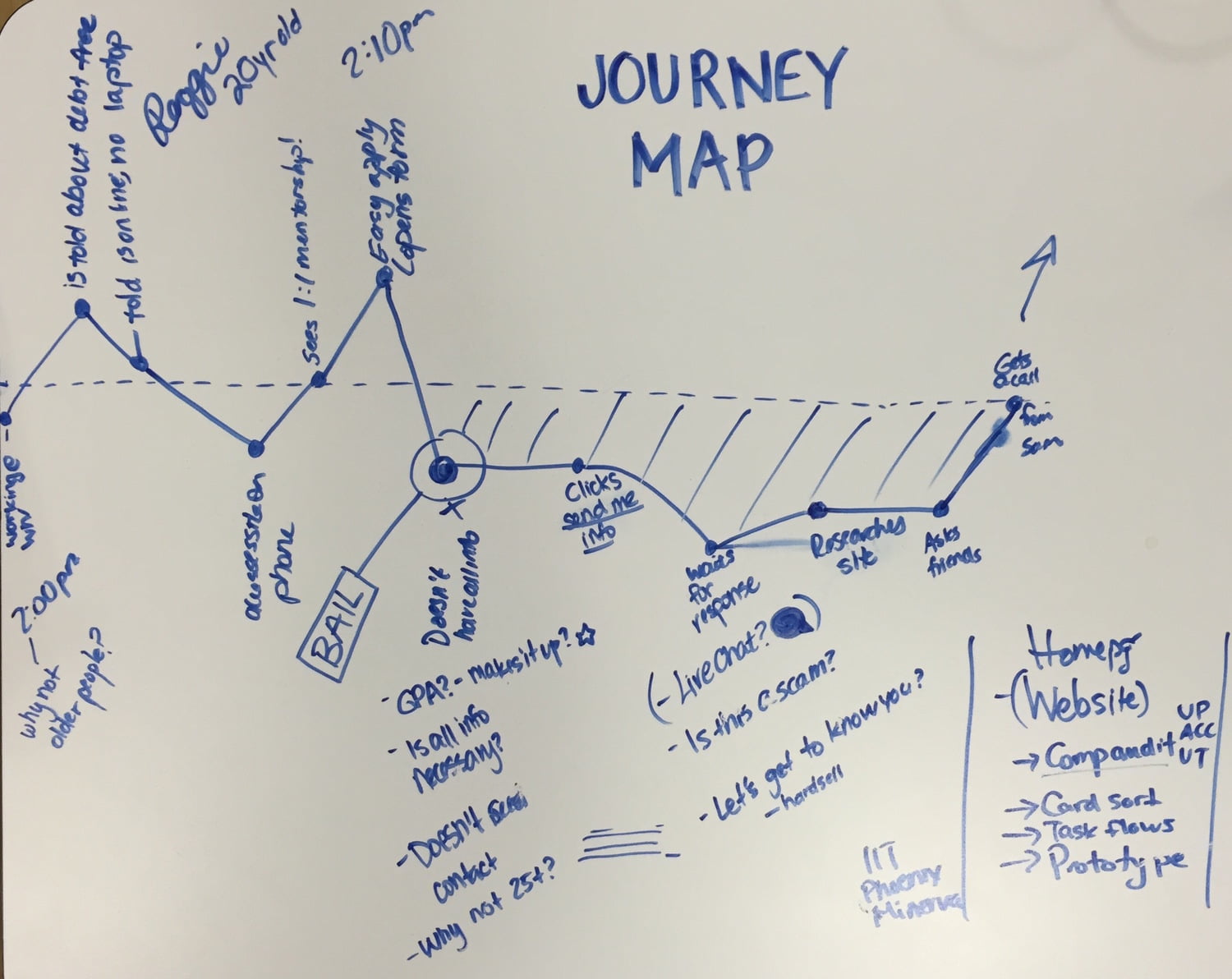
.jpg)
You can spend all day designing a beautiful website for your brand, but it’s moot if the user’s complex experience isn’t taken into account. And this doesn’t just go for website interactions; the way a user interacts with your brand across all media is something you need to understand before you can create content that resonates.
Before you can determine the end of a user’s journey (hopefully a conversion), you have to understand every step of the journey. This is why we create user journey maps.
As noted by branding and UX expert Naomi Niles:
“What you prefer or what your designer prefers doesn’t matter if it’s not getting you conversions.”
In short, every part of your digital and brand interface should serve a user’s journey, not the whims and desires of people inside the company.
A JOURNEY MAP IS USEFUL IN PRESENTATIONS (AND BEYOND)
Creating a user journey map is a helpful way to understand what makes a user convert, and, conversely, what makes a user lose interest. In a series of steps, you’ll be able to see how a user first comes to your organization, what she experiences in those initial discovery phases, what makes her stay and convert, and what can make her become a loyal advocate after the process is over.
So why do you have to visually map it out? It’s useful for presentations where you need to show key stakeholders within your organization why you need to invest in certain areas of the digital experience. It’s a visual tool that can show:
- Ways users currently do interact with your brand; and
- Ways they could or should interact with your brand.
If a project or campaign has lived in a vague space for a while, journey maps can bring tangible logistics into play, especially as it relates to conversions. Showing the team and other stakeholders how the campaign will work with a user in each phase can clarify the overall vision.

Quick Example: If you’re trying to launch a video series that encourages donations to your organization, you can demonstrate the effectiveness of this campaign through a user journey map. Show that the user is not used to being told stories by nonprofits—that she expects a bald request for money instead of a story that shows the value of involvement in the organization. Show how, after being exposed to the video via a local YouTube influencer, she clicks over to the landing page, and is led through a series of fun, educational steps that cause her to be even more emotionally invested in the donation. After she makes the donation, show how follow-up with the influencer and other videos can remind her of the value of her contribution, and encourage her to be advocate for the cause on her own social media.
Another way user journey maps are useful is for a deeper understanding of user behavior and how it relates to content you create. If you’re struggling for creative guidance on content, knowing what your user expects vs. what she wants – and when she wants it – can help guide a tone of voice for content. For example, if she’s expecting a request for money that involves lots of statistics in text form, surprise and delight her with a video that tells a very personal story, from the point of view of a person who is helped by your cause.
The bottom line is that the more you know about your customer, the better you can appeal to them. Knowing what their journey is as they’re introduced to your organization can only help when making decisions about content meant to keep them interested.
GOOD THING YOU CREATED ALL THOSE PERSONAS
In a recent blog post, I covered the whys and hows of audience personas, and provided an example of an audience persona that provides key information. I recommend creating 2-4 personas for your audience, keeping in mind that each persona likely has a slightly different user journey. Crafting those personas is where the major amount of research takes place, but once you do it, you’ll know valuable information: what drives your customer, what motivates her, what turns her off, and where she gets her information.
You can use information from your persona to answer questions like where she first becomes aware of your brand, what factors in her life will play into her decision to interact with it, what kind of interaction she expects and wants, and the reason she would return to your brand in the future.
A JOURNEY MAP: STEP BY STEP
Your journey map will likely have 12 or more steps in it , and the steps should cover these four major phases of the cycle:
- Awareness – Where and how the user first encounters your organization. Is it through a YouTube influencer? A Facebook ad? What channels does she come to your organization via and why does she click over?
- Acquisition – When the user visits your site or wherever your digital campaign lives, what kinds of actions does she take? What does she click on and what does it drive her to do? What steps does your organization require her to take before deciding to make a monetary or converting decision?
- Retention – At what moment does the user decide to convert? What prompts it and what happens immediately after to nurture that purchase? How long is this after her first point of brand awareness? How does she see the fruits of her donation?
- Loyalty – After the conversion is complete, what interactions does she have with the brand that inspire her to share the experience with her friends, either in person or on social media? Does she receive emails and how regularly?
A more detailed user journey map takes into account negative interactions as well – what causes the user to click away? When is the user unhappy with an interaction and how do you prompt that user to come back? These negative pain points could be useful when presenting a journey map that your campaign improves upon.
In each step you write – with your brand personas handy – make sure to look at it through theses lenses:
- Context – Does this step make sense in the context of your user? Look at your brand persona. Does the step you are expecting your user to make fit into the context of her life? Is there a way you make the step make more sense?
- Progression – Does this step naturally arise from the step before it? Does it prompt the user to take the next step?
- Devices – On what device is your user interacting with your organization at this step? Is it a different device from other steps, and should your content be different because of that? How does the medium affect the likelihood of taking the next step?
- Functionality – Does your interface encourage the kinds of actions you’re expecting the user to take? On a more technical level, what about your UX could be improved upon, or what about it already makes this step seamless for the user?
- Emotion – Think empathically here. What is your user feeling at the moment of this step? Is she frustrated? Does she not want to be sold to? Does she want more storytelling? A clearer vision of what a commitment looks like? Really put yourself in the user’s shoes to understand how emotion drives decisions.
[Source:- Social media today]
jacktoto
toto slot
link slot
jacktoto
situs togel
situs toto
jacktoto
togel online
situs togel
jacktoto
bo togel
jacktoto
bandar togel
jacktoto
jacktoto
jacktoto
bo toto
jacktoto
bocoran hk
situs slot gacor
toto macau
togel online
togel resmi
situs bandar togel
bandar togel
situs slot
bandar togel
bandar togel
bandar togel
bandar togel
toto macau 5d
situs slot gacor
situs slot
jacktoto
jacktoto
jacktoto
situs toto
bandar togel
situs toto
toto togel
situs togel
situs toto
bandar togel
toto slot
situs togel
situs toto
jacktoto
jacktoto
https://www.slot.pn-kuningan.go.id/
jacktoto
situs toto
situs toto
situs togel
situs togel
toto togel
situs togel
jacktoto
situs togel
jacktoto
toto togel
toto slot
jacktoto
situs toto
situs toto





